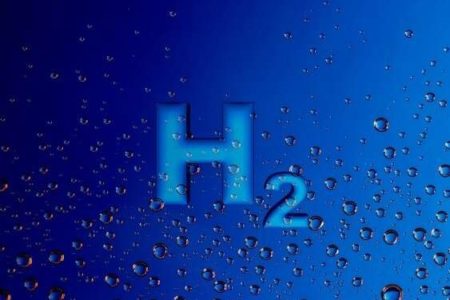March 1, 2020 – I’ve always blamed the lack of hydrogen’s ascendance to the Hindenburg (see image above). The 1937 crash and fire of Germany’s premier zeppelin seemed a telling blow to hydrogen’s use for commercial purposes. But it was the very property, the volatility of the gas making it a potential clean energy source to replace carbon-laden fossil fuels that consumed the zeppelin and demonstrated the incredible energy potential.
Hydrogen continues to intrigue those looking at alternate energy sources to help us combat the growing global climate crisis. Finding ways to produce it cleanly is one line of research. And harvesting it from waste and wastewater is another. Today, the bulk of commercial hydrogen, called grey hydrogen, gets produced through a process called steam methane reforming that mixes natural gas with air in controlled combustion to yield hydrogen and carbon monoxide. Because natural gas is sourced for hydrogen production, the methane release at the point of extraction becomes a net greenhouse gas (GHG) contributor. So researchers are looking for better ways to produce what they call green hydrogen.
Several methods are under consideration.
- Electrolysis
- Pyrolisis
- Solar cells
- Phototropic bacteria in wastewater
- Rust
Green Hydrogen from Electrolysis
Applying an electric charge to water that is a commonly known way to split water molecules into hydrogen and oxygen. Early attempts used slightly alkaline water in the process. But greater yields became apparent when the water was made acidic.
Traditional electrolytic catalysts contain platinum and iridium, the latter with known brittle characteristics that cause it to dissolve relatively quickly in acidic water. And since neither metal is cheap and iridium needs frequent replacement, hydrogen from electrolysis has been largely an uncompetitive commercial process when compared to grey hydrogen production using natural gas.
But new research at the Institute of Chemical Research of Catalonia is experimenting with catalysts made from cobalt and tungsten to form polyoxometalate, a material that is durable and works well in acidic water. Since these two metals are far more abundant than iridium it makes hydrogen from electrolysis more cost-competitive. The Catalonia team has also discovered a partially hydrophobic material, meaning it is water repellant, in which they have encased the catalyst further enhancing its durability.
At Monash University in Australia, researchers are also replacing iridium with “elements that are abundant, cheap, and operate in a more stable manner,” states Alexandr Simonov, a lecturer at the school. Described as a self-healing system, it has demonstrated stability in highly acidic conditions in temperatures up to 80 Celsius (176 Fahrenheit) degrees with no catalytic degradation. The goal is to produce a portable electrolyzer that could be transported by truck to wherever cheap renewable energy is available to set up industrial small-scale hydrogen production.
Decarbonized Hydrogen from Pyrolysis
Last June, a study done by a German consultancy firm, Pöyry, looked at pyrolysis as a cheaper, more scalable means of hydrogen production than electrolysis.
Pyrolysis is a process that involves the decomposition of methane (CH4) into hydrogen and pure carbon in solid form rather than as a gas. Solid carbon doesn’t contribute GHGs to the atmosphere. It requires no capture and underground storage and can be used as an industrial material for carbon fibre, tires, concrete, and graphene production.
Seen as a way to use natural gas to produce hydrogen at scale for the energy sector without the GHG emissions produced by the steam methane reforming process and, therefore, without the need for some form of carbon capture and sequestration (CCS).
In any case, this was a proposal, and not definitive, so we have yet to see even a pilot pyrolysis hydrogen production process.
A New Solar Cell That Turns Energy Into Hydrogen
At Ohio State University, researchers have developed a solar cell that harvests energy from sunlight using a single molecule catalyst that absorbs photons to create hydrogen as a byproduct. The key to the process is the single-molecule rhodium catalyst that can absorb energy from infrared to ultraviolet as well as the entire visible spectrum.
The researchers shone light into acid solutions containing the molecule and discovered it was outputting hydrogen. States Claudia Turro, Chemistry professor and Director of the Ohio State Center for Chemical and Biophysical Dynamics, “I think the reason it works is because the molecule is difficult to oxidize … And we have to have renewable energy. Just imagine if we could use sunlight for our energy instead of coal or gas or oil, what we could do to address climate change.” What is so neat about this technology is the combining of solar power with hydrogen and producing both with zero emissions.
Phototropic Bacteria in Wastewater Produces Bio-Hydrogen
Purple phototropic bacteria growing in wastewater is being evaluated for its hydrogen production potential. The research done at King Juan Carlos University in Madrid, Spain, showed that the purple bacteria could recover almost 100% of carbon from any type of organic waste while producing useful materials including hydrogen.
The variety produced was based on nutrient, temperature, and light intensity within the wastewater environment. Researchers were able to create a variety of end products by affecting bacterial metabolism. For example, adding nitrogen-rich waste produced biomass for animal food additives. Waste lacking organic nutrients produced polyhydroxyalkanoate (PHA), a polyester component for bioplastic production. And butyrate-containing organic waste produced biogenic hydrogen.
A maximum amount of hydrogen was produced using a mixture of malic acid and sodium-glutamate which minimized the production of carbon dioxide (CO2). It also found that when it connected electrodes to the culture, the bacteria produced considerable amounts of hydrogen and negligible traces of CO2.
Using Rust and Water-Methanol to Make Hydrogen
Research at the Tokyo University of Science have created a photocatalytic hydrogen process using an inexpensive ferrous-oxide (rust) catalyst exposed to light. The rust catalyst placed in a water-methanol solution when exposed to light from a mercury-xenon lamp produced copious amounts of the gas.
The common occurrence of the rust, called goethite, found in sediment and the base in brown ochre pigment, gives the nascent hydrogen production industry a material that can kickstart commercial hydrogen production.
The goethite catalyst in the presence of light outproduces at a 25-times rate, catalysts made from materials like titanium dioxide. The role oxygen plays in process is still not understood. It was noted that when oxygen was removed from the experimental chamber, hydrogen production ceased. Also noted was that the continued presence of rust stopped hydrogen from recombining with oxygen. The initial process continuously produced hydrogen for more than 400 hours.
Final Words
The potential for hydrogen to be a gamechanger in the energy mix of our 21st-century world cannot be underestimated. Hydrogen can combust to drive vehicles. Hydrogen fuel cells can power industries, homes, vehicles, and be backup storage for utilities. And hydrogen can do all of this with zero emissions, making no contribution to global warming and smog. If one or more of these hydrogen production processes can scale, then we will have added another versatile energy source to the mix. We just have to avoid a kaboom like the one that destroyed the Hindenburg.


















